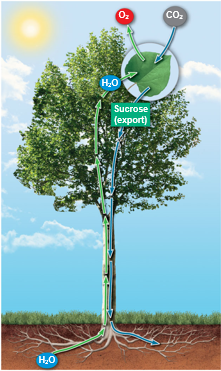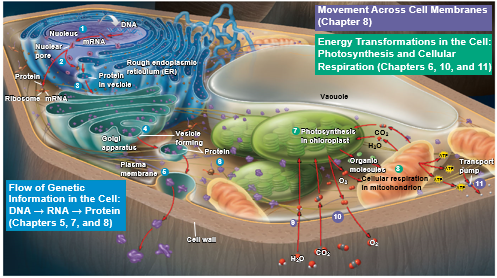C11 | Photosynthetic Processes
The Process that Feeds the Biosphere
Chloroplasts - Plants and other photosynthetic organisms contain organelles called?
Photosynthesis - The process that converts solar energy into chemical energy with chloroplasts.
(True) Directly or Indirectly, photosynthesis nourishes almost the entire living world.
Autotrophs - Are “self-feeders” that sustain themselves without eating anything derived from other organisms.
Autotrophs - They are the producers of the biosphere, producing organic molecules from CO2 and other inorganic molecules.
Photoautotrophs - Almost all plants are _, which uses the energy of sunlight to make organic molecules.
Yes - Can other organisms also benefit from photosynthesis?
(True) Photosynthesis occurs in plants, algae, certain other unicellular eukaryotes, and some prokaryotes.
Heterotrophs - Obtain organic material from other organisms.
Heterotrophs - Are the consumers of the biosphere. Some eat other living organisms, while some consume dead organic material or feces.
Decomposers - Consume dead organic material or feces.
(True) Almost all heterotrophs, including humans, depend on photoautotrophs for food and O2.
Remains of Organisms - Earth’s supply of fossil fuels was formed from the ____ that died hundreds of millions of years ago.
(True) Fossil fuels are being consumed faster than they are being replenished.
Photosynthetic Process - Researchers are exploring methods of using _ to produce alternative fuels.
Concept 11.1: Photosynthesis Converts Light Energy to the Chemical Energy of Food
Photosynthetic Bacteria - Chloroplasts are usually similar to and likely evolved from, what?
Structural Organization of Organelles - It allows for the chemical reactions of photosynthesis.
Chloroplasts: The Sites of Photosynthesis in Plants
Leaves - Are the major locations of photosynthesis in plants.
Mesophyll - It’s the interior tissue of the leaf. Chloroplasts are found mainly in the cells here.
30-40 - Each mesophyll cell contains _ chloroplasts.
Stomata - CO2 enters and O2 exits the leaf through microscopic pores called?
Stroma - A chloroplast has an envelope of two membranes surrounding a dense fluid called?
Thylakoids - Connected sacs in the chloroplast that compose a third membrane system.
Grana - Columns of stacked thylakoids
Chlorophyll - Pigment that gives leaves their green color, which resides in the thylakoid membranes.
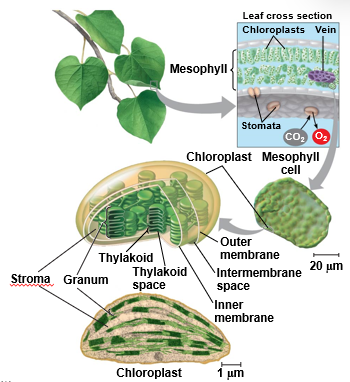 Tracking Atoms Through Photosynthesis: Scientific Inquiry
Tracking Atoms Through Photosynthesis: Scientific Inquiry
Photosynthesis - A complex series of reactions that be summarized in a certain equation.
6 CO2 + 12 H20 + Light Energy → C6H12O6 + 6 O2 + 6 H2O - The chemical equation for photosynthesis
(True) The overall chemical change during photosynthesis is the reverse of the one that occurs during cellular respiration.
The Splitting of Water
Chloroplasts - Split H2O into hydrogen and oxygen, incorporating the electrons of hydrogen into sugar molecules and releasing oxygen as a by-product.
 Photosynthesis as a Redox Process
Photosynthesis as a Redox Process
Reverses - Photosynthesis the direction of electron flow compared to respiration.
Redox Process - Photosynthesis is a _ process in which H2O is oxidized and CO2 is reduced.
Endergonic Process - Photosynthesis is an ____; the energy boost is provided by light.
 Two Stages of Photosynthesis: A Preview
Two Stages of Photosynthesis: A Preview
(True) Photosynthesis consists of the light reactions and Calvin Cycle.
Light Reaction - The Photo Part
Calvin Cycle - The Synthesis Part
Light Reactions in the Thylakoids
- Split H2O
- Release O2
- Reduce the Electron Acceptor NADP+ to NADPH
- Generate ATP from ADP by Photophosphorylation
Split H2O, Release O2, Reduce Electron Acceptor NADP+ to NADPH, ATP-ADP by Photophosphorylation - The Four Light Reactions in the Thylakoids.
ATP, NADPH - The Calvin Cycle in the stroma forms sugar into CO2 using?
Carbon Fixation - Calvin Cycle begins with _, incorporating CO2 into organic molecules.
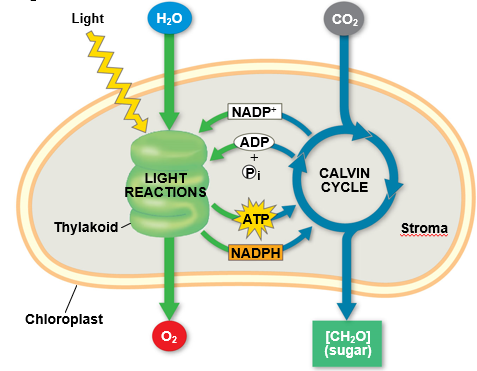 Concept 11.2: The Light Reactions Convert Solar Energy to Chemical Energy of ATP and NADPH
Concept 11.2: The Light Reactions Convert Solar Energy to Chemical Energy of ATP and NADPH
Chloroplasts - Solar powered chemical factories.
Thylakoids - The _ of chloroplasts transform light energy into the chemical energy of ATP and NADPH.
The Nature of Sunlight
Light - It is electromagnetic energy.
Electromagnetic Radiation - Light is also called?
Wavelength - The distance between crests of electromagnetic waves.
Wavelength - It determines the type of electromagnetic energy.
Electromagnetic Spectrum - Is the entire range of electromagnetic energy or radiation.
Visible Light - Consists of wavelengths (380nm to 750nm) that produce the colors we see.
(True) Visible light also includes the wavelengths that drive photosynthesis.
Photons - Light also behaves as though it consists of discrete particles, called?
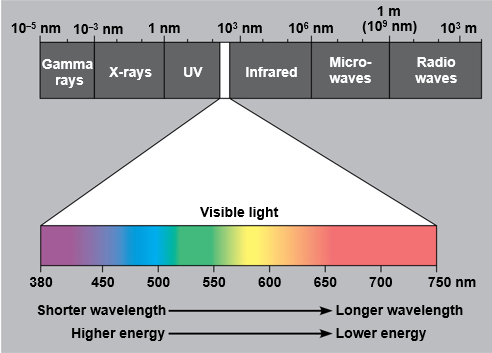 Photosynthetic Pigments: The Light Receptors
Photosynthetic Pigments: The Light Receptors
Pigments - Substances that absorb visible light.
(True) Different pigments absorb different wavelengths.
Reflected or Transmitted - Wavelengths that are not absorbed are either?
(True) Leaves appear green because chlorophyll reflects and transmits green light.
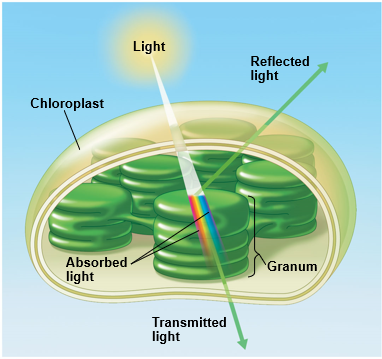 Spectrophotometer - Measures a pigment’s ability to absorb various wavelengths.
Spectrophotometer - Measures a pigment’s ability to absorb various wavelengths.
Spectrophotometer - This machine sends light through pigments and measures the fraction of light transmitted at each wavelength.
Absorption Spectrum - A graph plotting a pigment’s light absorption vs wavelength.
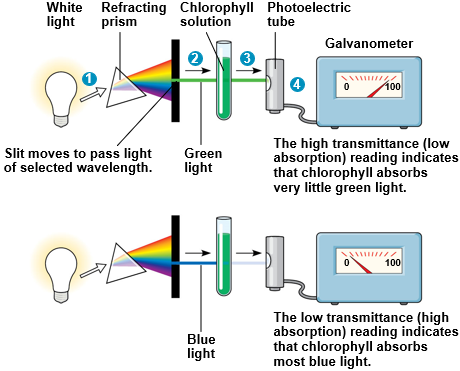 Chlorophyll a, Chlorophyll b, Carotenoids - Three Types of Pigments in Chloroplasts
Chlorophyll a, Chlorophyll b, Carotenoids - Three Types of Pigments in Chloroplasts
Chlorophyll a - The key light-capturing pigment.
Chlorophyll b - An accessory pigment.
Carotenoids - A separate group of accessory pigments.
Violet-Blue, Red Light - The absorption spectrum of chlorophyll a suggests that and ___ light work best photosynthesis.
Action Spectrum - Profiles the relative effectiveness of different wavelengths of radiation in a driving process.
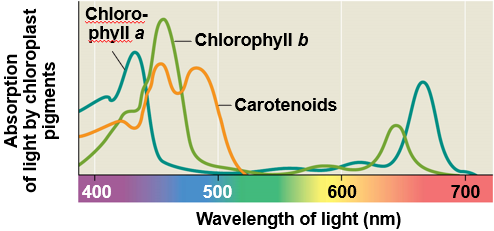
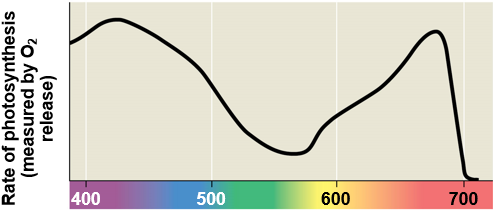
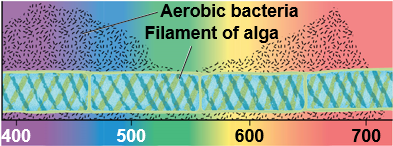 1883 - The action spectrum of photosynthesis was first demonstrated in?
1883 - The action spectrum of photosynthesis was first demonstrated in?
Theodore W. Engelmann - Who demonstrated the action spectrum.
Filamentous Alga - In this experiment, Engelmann exposed different segments of _ to different wavelengths.
O2 - Areas receiving wavelengths favorable to photosynthesis produced excess __.
Aerobic Bacteria - In the action spectrum of photosynthesis, Engelmann used their growth as a measure of O2 production.
(True) The action spectrum for photosynthesis is broader than the absorption spectrum of chlorophyll.
Chlorophyll b - Accessory pigments, such as , broaden the spectrum used for photosynthesis.
Slight Structural Difference Between Pigment Molecules - The difference in the absorption spectrum between chlorophyll a and b is due to a?
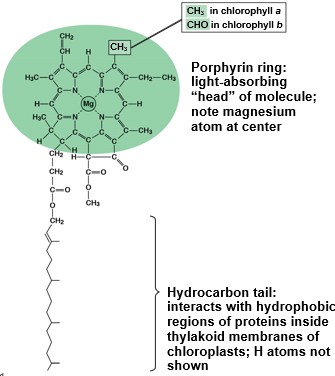 Carotenoids - Accessory pigments, that may broaden the spectrum of colors that drive photosynthesis.
Carotenoids - Accessory pigments, that may broaden the spectrum of colors that drive photosynthesis.
Photoprotection - Some carotenoids function in _. They absorb excessive light that would damage chlorophyll or react with oxygen.
Excitation of Chlorophyll by Light
Unstable - When a pigment absorbs light, it goes from a ground state to an excited state, which is?
Released - When excited electrons fall back to the ground state, excess energy is _ as heat.
Isolation - In this, some pigments also emit light, an afterglow.
Fluorescence - What do you call the emitted afterglow that occurs during isolation.
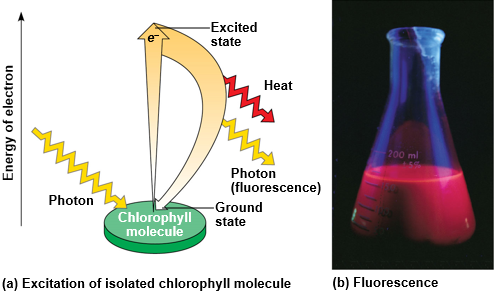 A Photosystem: A Reaction-Center Complex Associated with Light-Harvesting Complexes
A Photosystem: A Reaction-Center Complex Associated with Light-Harvesting Complexes
Photosystem - Consists of a reaction-center complex, surrounded by light-harvesting complexes.
Reaction-Center Complex - An association of proteins holding a special pair of chlorophyll a molecules and a primary electron acceptor.
Light-Harvesting Complex - Consists of pigment molecules bound to proteins.
Transfer an Excited Electron to a Different Molecule - Why are chlorophyll a molecules special?
Primary Electron Acceptor - In the reaction center, they accept excited electrons and is reduced as a result.
First Step of the Light Reactions - Solar-powered transfer of an electron from a chlorophyll a molecule to the primary electron acceptor is the?
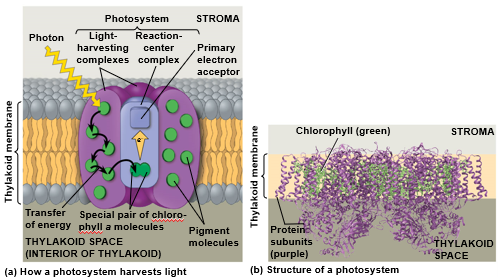 Photosystem II (PS II), Photosystem I (PS I) - Two types of photosystems in the thylakoid membrane.
Photosystem II (PS II), Photosystem I (PS I) - Two types of photosystems in the thylakoid membrane.
Photosystem II (PS II) - Functions first. (The numbers reflect order of discovery)
P680 - The reaction-center chlorophyll a of PS II is called?
680nm - P680 is named such because it is best at absorbing a wavelength of?
Photosystem I (PS I) - Photosystem best at absorbing a wavelength of 700nm.
P700 - The reaction-center chlorophyll a of PS I
Linear Electron Flow
Cyclic, Linear - Two possible routes for electron flow during light reactions.
Linear Electron Flow - The primary pathway. Involves both photosystems.
ATP, NADPH - Using light energy, the linear electron flow produces?
Eight Steps - How many steps are involved in the linear electron flow?
A photon hits a pigment in a light-harvesting complex of PS II. Its energy is passed among pigment molecules until it excites reaction-center, P680.
An excited electron from P680 is transferred to the primary electron acceptor, P680+.
H2O is split by enzymes and the electrons are transferred from the hydrogen atoms to P680+, thus reducing it to P680.
P680+ - Is the strongest known biological oxidizing agent.
Thylakoid Space - The H2 are released into the?
O2 is released as a by-product of this reaction.
Each electron falls down an electron transport chain from the primary electron acceptor of PS II to PS I. Energy released by the fall drives the creation of a proton gradient across the thylakoid membrane.
Potential energy stored in the proton gradient drives production of ATP by chemiosmosis.
In PS I, transferred light energy excites P700, which loses an electron to the primary electron acceptor (like PS II)
P700+ - P700 that is missing an electron. It accepts an electron passed down from PS II via the electron transport chain.
Each electron falls down an electron transport chain from the primary electron acceptor of PS I to the Protein Ferredoxin (Fd).
NADP+ Reductase catalyzes the transfer of electrons to NADP+, reducing it to NADPH.
Calvin Cycle - Electrons of NADPH are available for the reactions of?
Removes H+ From the Stroma - What does the 8th step do?
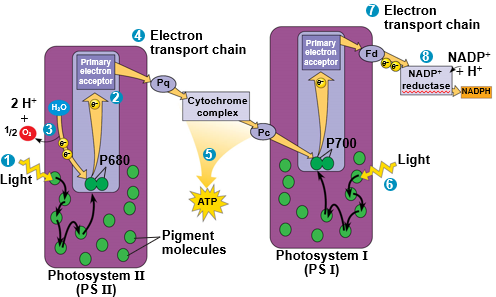 Mechanical Analogy - The energy changes of electrons during linear flow through the light reactions can be shows in a?
Mechanical Analogy - The energy changes of electrons during linear flow through the light reactions can be shows in a?
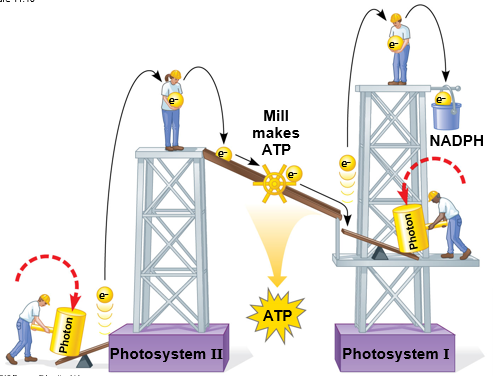 Cyclic Electron Flow
Cyclic Electron Flow
Cyclic Electron Flow - Electrons cycle back from Fd to the PS I reaction center.
Plastocyanin Molecule (Pc) - This allows electrons to cycle back to PS I from Fd.
(True) Cyclic electron flow uses only Photosystem I and produces ATP, but not NADPH. No oxygen is released, too.
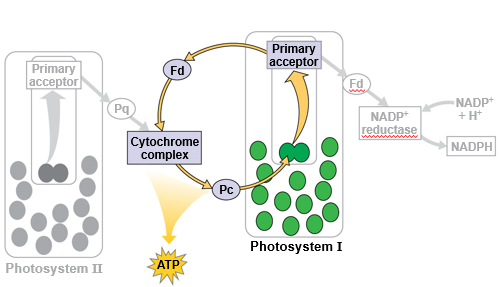 Purple Sulfur Bacteria - Some organisms have PS I, but not PS II. An example of this is?
Purple Sulfur Bacteria - Some organisms have PS I, but not PS II. An example of this is?
(False, before) Cyclic electron flow is thought to have evolved after linear electron flow.
(True) Cyclic electron flow may protect cells from light-induced damage.
A Comparison of Chemiosmosis in Chloroplasts and Mitochondria
Use Different Sources of Energy - Chloroplasts and mitochondria generate ATP by chemiosmosis, but?
Mitochondria - Transfers chemical energy from food to ATP.
Chloroplasts - Transform light energy into the chemical energy of ATP.
Spatial Organization - _ of Chemiosmosis differs between chloroplasts and mitochondria, but also shows similarities.
Intermembrane Space, Mitochondrial Matrix - In mitochondria, protons are pumped to the and drive ATP synthesis as they diffuse back into the .
Intermembrane Space - The space between two or more cellular membranes. In mitochondrion’s case, between the outer and inner membrane.
Thylakoid Space, Stroma - In chloroplasts, protons are pumped into the _ and drive ATP synthesis as they diffuse back into the _.
Chemiosmosis - The process of moving ions (i.e. protons) to the other side of a biological membrane, generating an electrochemical gradient, which can then be used to drive ATP.
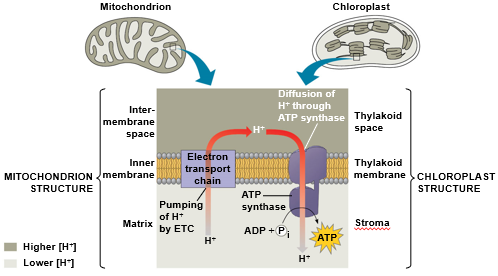 Stroma - ATP and NADPH are produced on the side facing the , where the Calvin Cycle takes place.
Stroma - ATP and NADPH are produced on the side facing the , where the Calvin Cycle takes place.
(True) Light reactions generate ATP and increase the potential energy of electrons by moving them from H2O to NADPH.
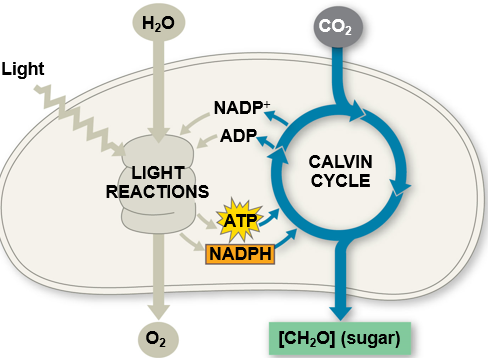
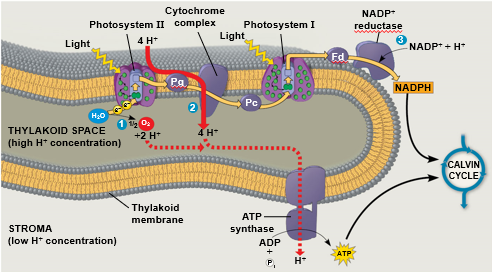
Concept 11.3: The Calvin Cycle Uses the Chemical Energy of ATP and NADPH to Reduce CO2 to Sugar
Regenerates - The Calvin Cycle, like the citric acid cycle, ___ its starting material after molecules enter and leave the cycle.
Anabolic - The Calvin Cycle is ; it builds sugar from smaller molecules using ATP and the reducing power of electrons carried by NADPH.
Glyceraldehyde 3-Phosphate (G3P) - Carbon enters the calvin cycle as CO2 and leaves as a sugar named?
Three - One G3P costs cycles to make, converting molecules of CO2.
Carbon Fixation, Reduction, Regeneration of CO2 Acceptor - Three Phases of the Calvin Cycle
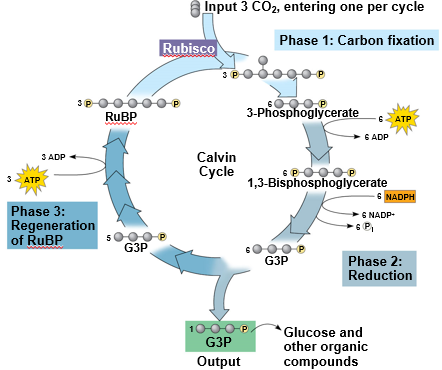 Concept 11.4: Alternative Mechanisms of Carbon Fixation Have Evolved in Hot, Arid, Climates
Concept 11.4: Alternative Mechanisms of Carbon Fixation Have Evolved in Hot, Arid, Climates
Dehydration - Is a problem for plants, sometimes requiring trade-offs with other metabolic processes, especially photosynthesis.
Stomata - On hot, dry days, plants close _, which conserves H2O, but also limits photosynthesis.
Photorespiration - The closing of stomata reduces access to CO2 and causes O2 to build up. This is a wasteful process, called?
Photorespiration: An Evolutionary Relic?
Photorespiration - The process by which in the presence of light, plants consume oxygen and release carbon dioxide (instead of fixing them-carbon fixation).
3-Phosphoglycerate - In most C3 plants, initial fixation of CO2 via rubisco forms a three-carbon compound called?
Photorespiration - Consumes O2 and organic fuel and release CO2 without producing ATP or sugar.
Rubisco - Photorespiration may be an evolutionary relic because _ first evolved at a time when the atmosphere had far less O2 and more CO2.
Calvin Cycle - Photorespiration limits damaging products of light reactions that build up in the absence of?
50% - In many plants, photorespiration is a problem because on a hot, dry, day, it can drain as much as __% of the carbon fixed by the Calvin Cycle.
C4 Plants
C4 Plants - Minimize the cost of photorespiration by incorporating CO2 into four-carbon compounds.
Bundle-Sheath Cells, Mesophyll Cells - Two distinct types of cells in the leaves of C4 plants.
Bundle-Sheath Cells - Arranged in tightly packed sheaths around the veins of the leaves.
Mesophyll Cells - Are loosely packed between the bundle sheath and the leaf surface.
Sugar production in the C4 plants occurs in a three-step process:
Production of four-carbon precursors is catalyzed by the enzyme PEP Carboxylase in the mesophyll cells.
PEP Carboxylase has a higher affinity for CO2 than rubisco does. It can fix CO2 even when CO2 concentrations are low.
The four-carbon compounds are exported to the Bundle-Sheath cells.
With the bundle-sheath cells, they release CO2 that is then used in the Calvin Cycle.
Production of Four-Carbon Precursors in Mesophyll, Exported to Bundle-Sheath Cells, Bundle-Sheath Cells Release CO2 to be used in the Calvin Cycle - The three-step process of sugar production in C4 plants.
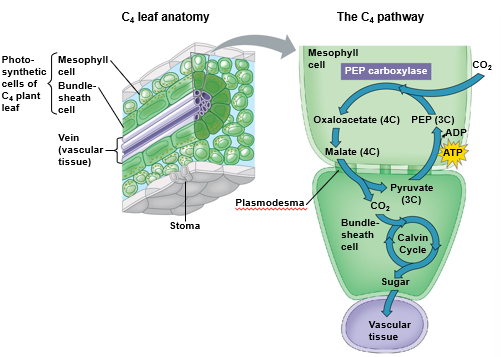 Industrial Revolution - Since the _ in the 1800s, CO2 levels have risen greatly.
Industrial Revolution - Since the _ in the 1800s, CO2 levels have risen greatly.
(True) Increasing levels of CO2 may affect C3 and C4 plants differently, perhaps changing the relative abundance of these species. The effects of such changes are unpredictable and a cause for concern.
Suitable Agricultural Land - Is decreasing due to the effects of climate change, while the world demand for food continues to increase.
C4 Photosynthesis - Uses less water and resources than a C3 photosynthesis.
30-50% - Scientists have genetically modified rice: A C3 plant carries out C4 photosynthesis. Results show that an estimate of -% increase in rice yield compared to plain C3 rice.
CAM Plants
Crassulacean Acid Metabolism - Some plants, including succulents use this to fix carbon.
CAM Plants - Open their stomata at night, incorporating CO2 into organic acids that are stored in the vacuoles. In the day, stomata closes and CO2 is released from organic acids, before being used in the Calvin Cycle.
Both incorporate CO2 in organic intermediates before it enters the Calvin Cycle - How are CAM Pathways similar to C4 Pathways?
(True) The C4 pathway structurally separates the initial steps of carbon fixation from the Calvin Cycle. In the CAM Pathway, these steps occur in the same cell, but are separated in time.
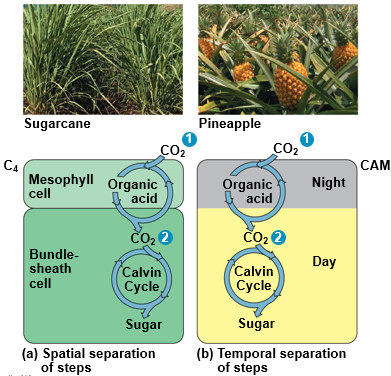 Concept 11.5: Life Depends on Photosynthesis: The Importance of Photosynthesis: A Review
Concept 11.5: Life Depends on Photosynthesis: The Importance of Photosynthesis: A Review
(True) Sunlight Energy enters chloroplasts and are stored as chemical energy in organic compounds.
Chemical Energy & Carbon Skeletons - Sugar made in the chloroplasts supplies these two to synthesize the organic molecules of cells.
Starch - Plants store excess sugar as _ in chloroplasts and other structures such as roots, tubes, seeds, and fruits.
